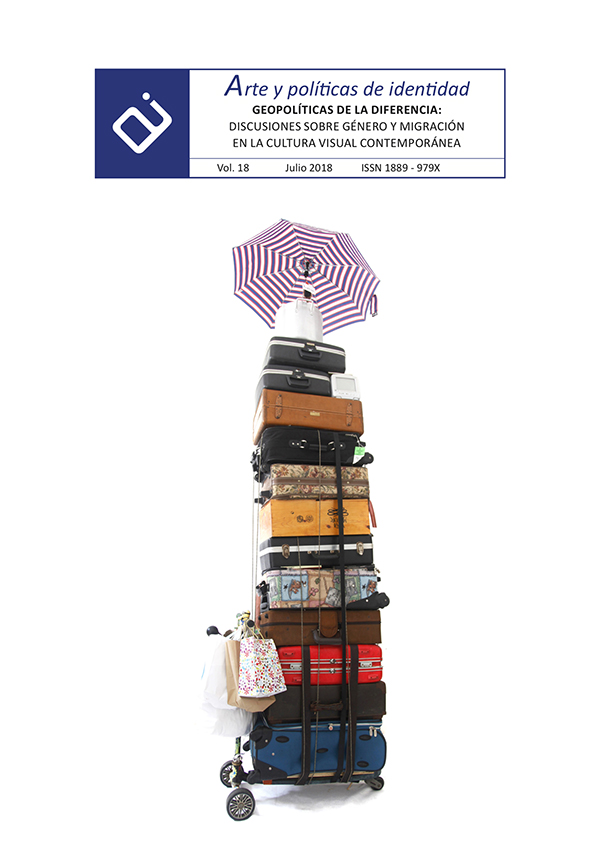El espacio-frontera y su inscripción en el cuerpo migrante
La operación contra-performativa de la obra Transborder Immigrant Tool
Resumen
Transborder Immigrant Tool (TBT) es un proyecto artístico que consiste en una aplicación para teléfonos móviles (una app) que se propone ayudar en la localización GPS de estaciones de agua, ubicadas en el desierto fronterizo, a los migrantes indocumentados en tránsito por la zona; y que cuenta con una serie de 24 poemas-instrucciones para la supervivencia en el ecosistema.
Este artículo se dirigirá a argumentar sobre el modo en que TBT visibiliza la condición del espacio Frontera, que es producido y performado epistemológicamente para reproducir dominancias que luego son inscritas en los cuerpos. Por otro lado, mostraré cómo este proyecto acusa la condición de estos, sometidos a una categorización racializada, cuestión que busca resistir a través de un emplazamiento poético, una contra-performatividad que se opone a las condiciones bio y necropolíticas que agudizan el tránsito de un Estado a otro.
Descargas
-
Resumen501
-
PDF509
Citas
Alan, I. P. (2011). From Lines to Territories. Ricardo Dominguez, Bang.Labs and the Transborder Immigrant Tool. Border Politics, Border Poetics (Tesis de Grado: Maestro en Artes en Historia y Teoría del Arte Contemporáneo). The San Francisco Art Institute, Sn. Francisco, California, EUA.
Beck, G. (2010). El adoctrinamiento de Fox Beck. Recuperado de http://www.criticalcommons.org/Members/markcmarino/clips/fox_beck_indoctrination_100902a.flv
Berardi, F. (2009). The dark side of the multitude. En Impasse: dilemas políticos del presente (pp. 69-94). Buenos Aires: Tinta Limón, .
BMI (2013). A Continued Humanitarian Crisis at the Border: Undocumented Border Crosser Deaths Recorded by the Pima County Office of the Medical Examiner, 1990-2012. Arizona: The Binational Migration Institute, The University of Arizona.
Broncano, F. (2009). La Melancolía del Ciborg. Barcelona: Herder.
Butler, J. (2004a). Undoing Gender. New York: Routledge.Butler, J. (2004b). Precarious Life: The Powers of Mourning and Violence. New York: Verso.
Butler, J. (2010). Marcos de guerra. Las vidas lloradas. Madrid: Espasa Libros.
Cárdenas, M. (2010). Hope Code, Recuperado de http://scalar.usc.edu/nehvectors/border-codes/codework
Carroll, A. S., (Marzo, 2013). Transborder Immigrant Tool. A Geo-Poetic System. En Arte útil. Conversations. Queens Museum of Art, N.Y. Recuperado de http://vimeo.com/63430636
Delgado, M. (2009, septiembre). Seres de otro mundo: Sobre la función simbólica del inmigrante. En Yago Mellado (coord.) La Dinámica del Contacto. Movilidad, encuentro y conflicto en las relaciones interculturales (pp. 12-22). Barcelona: Fundación CIBOG. Recuperado de http://www.cidob.org/es/publicaciones/monografias/monografias/la_dinamica_del_contacto_movilidad_encuentro_y_conflicto_en_las_relaciones_interculturales
Derrida, J. (1994). Márgenes de la Filosofía. 2ª ed.Madrid:Cátedra.
Dominguez, R. (2010). Dislocative Media: Transborder Immigrant Tool as Aesthetic Sustenance. Conferencia dictada en Literature. Culture. Media Center de la UCSB, en abril de 2010. Tomado de http://www.youtube.com/watch?v=bfdK2rwQ0XA
Dunbar, A. (2009, noviembre,). Follow the GPS, Ése. VICE. EEUU. Recuperado de http://www.vice.com/read/follow-the-gps-225-v16n11
EDT/b.a.n.g. lab. (2010). Sustenance a play for all [] Transborders.Recuperado de http://www.thing.net/~rdom/Sustenance.pdf
EDT (2014). The Transborder Immigrant Tool.La Herramienta Transfronteriza para Inmigrantes. Michigan: The University of Michigan, Ann Arbor. Recuperado de http://vision.centroculturadigital.mx/media/done/tbtbook-599.pdf
Estévez, A. (2014). The Politics of Death and Asylum Discourse: Constituting Migration Biopolitics from the Periphery. Alternatives: Global, Local, Political, 39(2), 75-89.
Foucault, M. (2000). Defender la sociedad. Curso en el Collège de France (1975-1976). Buenos Aires: Fondo de Cultura Económica.
Fuentes, M. A. (2013). Zooming in and out: Tactical Media Performance in Transnational Context. GPS (Global Poetic System). En Lichtenfels, P., Rouse, J., (Eds.) Performance, Politics and Activism (pp. 32-54). EEUU: Palgrave Macmillan.
Laclau, E. (1996). Emancipación y diferencia. Buenos Aires: Ariel.
Lander, E. (2000). Ciencias sociales: saberes coloniales y eurocéntrico. La colonialidad del saber: eurocentrismo y ciencias sociales. Perspectivas latinoamericanas (pp. 151-220). Buenos Aires: Consejo Latinoamericano de Ciencias Sociales, Col. Sur-sur.
Luhmann, N. (1996). Prefacio. En Corsi, G., y otros. (comps.), GLU: Glosario sobre la teoría social de Niklas Luhmann (pp. 11-13). México: Universidad Iberoamericana.
Mbembe, A. (2014). Teoría del Color. México: MUAC-UNAM.
Navarrete Linares, F. (2014, agosto-diciembre). Aproximaciones Contra el Racismo. En programa Campus Expandido. MUAC - Posgrado en Estudios Mesoamericanos - Posgrado en Historia del Arte, UNAM, México.
Schmidt, S. (2008, julio - diciembre). Amor de lejos: la emigración de México a Estados Unidos. en Norteamérica,v.3 (2).
SEMARNAT, (2015). Los desiertos de Sonora y Baja California. México: Instituto Nacional de Ecología. Recuperado de http://www2.inecc.gob.mx/publicaciones/artnopubli/368/asilvestres.html.
Stengers, I. (2005). The Cosmopolitical Proposal. En Latour, B. y Weibel, P., (eds.) Making Things Public. Atmospheres of Democracy (pp. 994-1003). Cambridge Massachusetts: ZKM y MIT.
Vila, P. (2005). Ethnography at the border. Minneapolis y Londres: University of Minnesota Press.
Žižek, S. (2010). En Defensa de la Intolerancia. Barcelona: Ediciones Sequitur.
Works published in this journal are subject to the following terms:
- The Service of Publications from the University of Murcia (publishing house) keeps the published works’ copyrights, and favors and allows the reuse of these works under the license indicated in point 2.
- Works are published in the journal’s online edition under the license Creative Commons Reconocimiento-NoComercial-SinObraDerivada 3.0 España(texto legal). They can be copied, used, disseminated, transmitted and publicly exhibited, as long as: i) the author and original source of publication are cited (journal, publishing house and work’s URL); ii) they are not used for commercial purposes; iii) the existence and specifications of this license are mentioned.
3. Conditions for auto-file. It is allowed and encouraged that authors share electronically their pre-print version (the pre-reviewed version) and /or post-print version (the reviewed and accepted version) of their Works before the publication, since it promotes its circulation and dissemination. RoMEO color: green.










